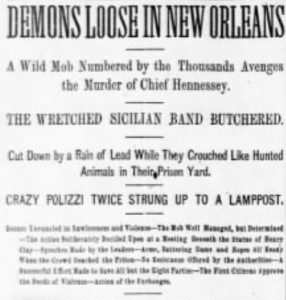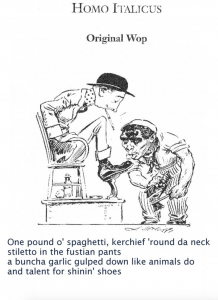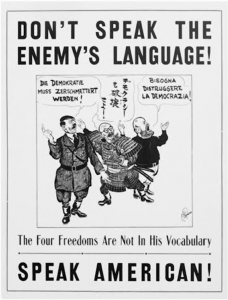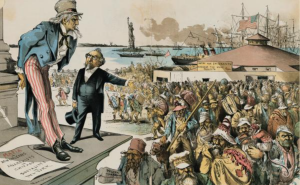“Demons Loose in New Orleans”, The Pittsburg Dispatch, March 15, 1891

This newspaper article was printed with no specified author on March 15, 1891. Its purpose was to inform the people of Pittsburg about the recent happenings in New Orleans regarding the lynching of 11 Italian immigrants. The immigrants were recently convicted and jailed, without much evidence, for the murder of a police chief in Louisiana named David Hennessy. Soon after, a mob of non-Italian locals broke into the prison and murdered 11 of the 19 imprisoned Italians with heavy influence from the anti-Italian rhetoric that was prevalent in the US at the time. This would become one of the largest lynching incidents in US history to this day. The article uses language that supports the murdering mob as opposed to the Italian victims as at the time Italians were victims of heavy prejudice across the US. This source is an example of one of the many hardships Italian immigrants faced. The prejudice against the Italian immigrants here is an early example of anti-immigrant sentiment.
“Homo Italicus: Original Wop.” Time , (1911).

This anti-Italian cartoon image that was published in Time magazine in 1911. Without any specific author named to the cartoon, the image drawn shows an inferior Italian man shining the shoes of an Anglo-Saxon man and underneath, prejudiced text suggests that Italian immigrants are unfit in the workplace and animal like in appearance and behavior. This cartoon aims to further the notion that Italian immigrants are less fit than Anglo-Saxons and its intended audience is everyone in America. The image of an Italian man shining this Anglo-Saxon’s shoes also suggests that Italian immigrants are best used to just work for Anglo-Saxons almost as servants. Italian immigrants were also not considered white at the time. They were often reffered to as “dagos” and were grouped between white and black people in the social heirarchy that formed in the United States during this time.
Don’t Speak the Enemies Language, poster (1917).

This is a propaganda cartoon that does not specify the author or location of publication but was a United States Government poster created in 1917 after the United States entered World War 1. It is intended for the non-immigrant citizens of the US and is loaded with anti-immigrant sentiment, specifically to immigrants from Italy, Japan, and Germany. It depicts the leaders of Italy, Japan, and Germany in a goofy looking manner as they were the enemies of the US in the war. The cartoon goes on to ostracize the speaking of the native language of all three enemy countries in the United States as “Don’t Speak the Enemy’s Language,” is slapped across the bottom in big bold lettering. Many states in the US would go on to forbid the teachings of all three languages in American schools during the duration of the war as a way of shaming the use of the language by the three immigrant groups in the US.
“Where the Blame Lies”, photo (1891)

Another political cartoon rootted in anti-italian sentiment, this cartoon was drawn in 1891 and depicts Uncle Sam looking over into a crowd of immigrants. He looks on the group with disgust along with another man dressed in a suit as the immigrants enter the United States. The Statue of Liberty in the back suggests it is Ellis Island. The immigrants in front have lables on them, representing and exadurating the fact that they are not citizens of the US. The one representing Italian immigrants has “Italian brigand” slapped across him, suggesting he does not belong in the US. “Where the Blame Lies,” is a symbolic title for the cartoon as well, as this is used to show that immigrants in the United States are to blame for all issues going on. It also is a shot at the United States Government for not mandating immigration more strictly.
